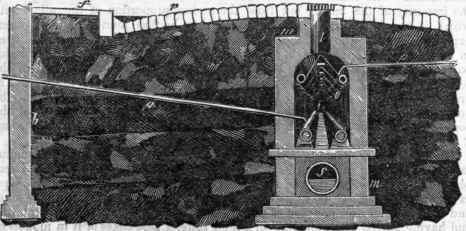Sewer
Description
This section is from the book "The Engineer's And Mechanic's Encyclopaedia", by Luke Hebert. Also available from Amazon: Engineer's And Mechanic's Encyclopaedia.
Sewer
A subterraneous channel or canal, formed in towns and other places, for draining and purifying them. They are made of such materials and forms as suit the circumstances of the locality, and come too often under the observation of the public to need our explanation. But in connexion with this subject we may mention the scheme of Subways, proposed by Mr. John Williams, of Cornhill, for which he took out a patent in 1822, and strove arduously to get adopted in the city of London. The title of the patent explains its object, viz., "a method to prevent the frequent removal of the pavement and carriage paths for laying down and taking up pipes, and for other purposes, in streets, roads, and public highways."

The nature of Mr. Williams's plan will be fully understood on inspection of the annexed drawing, representing a transverse section of the street.
r r represents the paved road-way; /, the foot-pavement; b, a section of the front wall of the basement story of a house, with a pipep to supply water from one of the mains o, contained in the sub-way. The opposite side of the diagram is incomplete, having been cut off for want of room; the pipe p there shown is for the supply of the house on that side, with either gas or water; the upper pipes, which may be supposed to belong to different companies, are suspended to the crown of the arch by iron straps. The lower pipes are supported upon the floor; m m shows the outline of the masonry; s, the common sewer, which has, at stated distances, openings into the sub-ways, but secured by air-tight doors, to prevent the escape of effluvia; I, one of the holes covered with a grating, for the admission of light and the circulation of air. The patentee proposes to build his "sub-ways," (as he terms them) when practicable, over the sewers, with drainage from them into the sewers; the dimensions are about 7 feet high and 4 feet wide, but these may be varied according to circumstances. Openings are to be made on the tops of the sub-ways, or tunnel, at every hundred feet, for the purpose of admitting air and light; and passages are to be made in the sides, to admit inspectors and workmen.
Along each side of these tunnels are to be arranged pipes, to supply the inhabitants of the streets under which they are built with water and gas.
Amongst the advantages enumerated by the patentee to be derived from the introduction of sub-ways, may be noticed the facility with which a line of pipes may be deposited along a street, without breaking up the pavement, and the consequent annoyance to the inhabitants, obstruction to the passengers, and detriment to the stability of the roads; the immediate access at all times to inspect the pipes, effect the requisite repairs, or obtain an additional supply of water in cases of fire, and better opportunities of repairing and clearing the common sewer, whether it be situated underneath or alongside of the sub-way.
Continue to:


